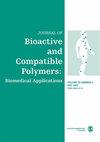Development of a three-dimensional in vitro blood-brain barrier using the chitosan-alginate polyelectrolyte complex as the extracellular matrix
IF 2.1
4区 生物学
Q3 BIOTECHNOLOGY & APPLIED MICROBIOLOGY
引用次数: 0
Abstract
Polyelectrolyte complexes (PECs) consist of a spontaneous assembly of oppositely charged polysaccharides. PECs can be used to obtain a hydrogel tissue scaffold in tissue culture. In this study, it is aimed to use PEC as a blood-brain barrier (BBB) model scaffold. By mixing polycationic chitosan and polyanionic alginate solutions at a certain ratio it was obtained a 3D hydrogel scaffold and mimicked in vivo environment of the tissue. The PEC hydrogel scaffold’s chemical, physical, and mechanical characterizations were performed with FTIR, DSC, DMA, and Micro-CT analyses. In order to develop an in vitro BBB model, the human neuroblastoma cell line (SH-SY5Y) and mouse astrocyte cell line (C8-D1A) were mixed into a hydrogel, which is the abluminal side of the BBB. Human microvascular endothelial cells (HBEC-5i) were seeded on the hydrogel, and it was aimed to mimic the luminal side of the BBB. The characterization of the BBB model was determined by measuring the TEER, observation of the cell morphology with SEM, performing the permeability of Lucifer Yellow, and observation of tight junction proteins with immunofluorescence staining. As a result, HBEC-5i cells expressed tight junction proteins (ZO-1 and Claudin-5), showed TEER of 340 ± 22 Ω.cm2, and the Lucifer Yellow permeability of 7.4 × 10−7 ± 2.7 × 10−7 cm/s, which was suitable for use as an in vitro BBB model. Using a hydrogel PEC composed of chitosan and alginate as an extracellular matrix increased the direct interaction of endothelial cells, astrocytes, and neurons with each other and thus obtained a much less permeable model compared to other standard transwell models. Graphical abstract壳聚糖-海藻酸盐多电解质复合物作为细胞外基质的体外三维血脑屏障的研制
聚电解质复合物(PECs)由带相反电荷的多糖自发组装而成。PECs可用于组织培养中获得水凝胶组织支架。本研究旨在利用PEC作为血脑屏障(BBB)模型支架。将聚阳离子壳聚糖和聚阴离子海藻酸盐溶液按一定比例混合,得到三维水凝胶支架,并模拟组织的体内环境。PEC水凝胶支架的化学、物理和机械特性通过FTIR、DSC、DMA和Micro-CT分析进行。为了建立体外血脑屏障模型,将人神经母细胞瘤细胞系(SH-SY5Y)和小鼠星形胶质细胞细胞系(C8-D1A)混合成水凝胶,这是血脑屏障的腹腔侧。人微血管内皮细胞(HBEC-5i)被植入水凝胶,目的是模拟血脑屏障的管腔侧。采用TEER测定、SEM观察细胞形态、Lucifer Yellow通透性、免疫荧光染色观察紧密连接蛋白等方法对血脑屏障模型进行表征。结果,HBEC-5i细胞表达紧密连接蛋白(ZO-1和Claudin-5), TEER为340±22 Ω。Lucifer Yellow的通透性为7.4 × 10−7±2.7 × 10−7 cm/s,适合作为体外血脑屏障模型。使用壳聚糖和海藻酸盐组成的水凝胶PEC作为细胞外基质,增加了内皮细胞、星形胶质细胞和神经元之间的直接相互作用,从而获得了比其他标准transwell模型低得多的渗透性模型。图形抽象
本文章由计算机程序翻译,如有差异,请以英文原文为准。
求助全文
约1分钟内获得全文
求助全文
来源期刊

Journal of Bioactive and Compatible Polymers
工程技术-材料科学:生物材料
CiteScore
3.50
自引率
0.00%
发文量
27
审稿时长
2 months
期刊介绍:
The use and importance of biomedical polymers, especially in pharmacology, is growing rapidly. The Journal of Bioactive and Compatible Polymers is a fully peer-reviewed scholarly journal that provides biomedical polymer scientists and researchers with new information on important advances in this field. Examples of specific areas of interest to the journal include: polymeric drugs and drug design; polymeric functionalization and structures related to biological activity or compatibility; natural polymer modification to achieve specific biological activity or compatibility; enzyme modelling by polymers; membranes for biological use; liposome stabilization and cell modeling. This journal is a member of the Committee on Publication Ethics (COPE).
 求助内容:
求助内容: 应助结果提醒方式:
应助结果提醒方式:


